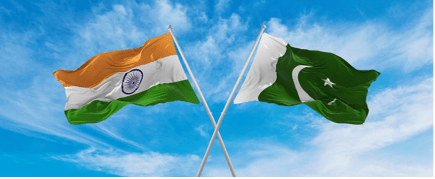
Sustainable peace between India and Pakistan is imperative for the regional stability, security and economic development of South Asia. Therefore, it is a profound necessity to explore avenues where both countries can engage and mutually benefit. In a globalized world, marked by economic integration and connectivity, it is a paradoxical dilemma that despite sharing common history, socio-economic similarities and geographical proximity, South Asia is the least integrated region in the world.
Pakistan and India can engage at multiple fronts and enhance people-to-people contact to sustain development and peace. But no matter how extensive a framework is created for exploring peace between Pakistan and India, if Kashmir is left out, a workable peace process and cooperation will be a far cry. The geopolitical contention demands a resolution to achieve sustainable peace. Thus, Kashmir sits at the core of any possibility of peace between Pakistan and India.
Hostility and lack of trust between India and Pakistan has a historical context. IThe two countries have fought multiple wars, experienced stand-offs, engaged in skirmishes and military aggressions. However, nothing conclusive has been achieved, rather both parties have paid hefty human and economic costs of the wars. As a result of hostility post-independence, aggression was not only limited to military actions but has also leaked onto the larger fabric of society in both countries. As a result, social and political systems radicalized, and led to cultural hostility, propagandist media campaigns, lack of economic integration and trust, border clashes and securitization of trans-boundary water resources (Javaid 2020).
The history holds witness to the realities of reconciliations and establishment of peace among conflicting and warring nations. Europe has fought multiple wars throughout its recorded history culminating in two World Wars. However, realizing the economic and human cost of the wars, European leaders found common grounds for sustainable peace for integration, economic interdependence and socio-cultural development. The Cold War was marked by disputes, proxy wars, conflicts, and polarization of global politics, but even under these conflicted scenarios the U.S.A. and the U.S.S.R. established economic and cultural linkages.
Defining and Contextualizing Peace between India and Pakistan
To explore solutions for peace between Pakistan and India, it is important to define peace, and the way its understanding can impact conflict resolution. Peace can be either ‘negative’ or ‘positive’ (Galtung 1996). Whereby, ‘negative peace’ is the ‘absence of violence’ and ‘positive peace’ refers to the integration of society and absence of ‘structural violence’ through measures which will prevent conflict (Galtung 1969). Johan Galtung, the principal founder of Peace and Conflict Studies, proposed comprehensive frameworks, both theoretical and conceptual, to understand causal relations between peace and violence. The peace process is not a static result of some events; it is a process to eliminate structural violence by understanding various conditionalities and social externalities.
Thus, for exploring peace, identification of the causal factors of violence across the socio-political spectrum is an imperative. Kashmir is the primary cause of ensuing violence and the conflicts that the post-independence Indo-Pak history entails. Besides, the systematic and structural violence that arose from perpetual conflicts has gotten ingrained in the national psyche that manifests in national narratives and state’s actions.
Identifying the Causes of Violence and Conflict between Pakistan and India
Peace building and conflict resolution between Pakistan and India has several layers to it, which are complex and demand comprehensive and integrated approaches. It will be prudent to identify the causal factors which instigate violence and perpetuate the historical conflicts between India and Pakistan.
Pakistan and India were impacted deeply as colonies of the British, which led to deep rooted inequalities and violence among political and social systems. Even after the Indian subcontinent gained independence, violence based on class, religion, and ideologies continued. The violence before and at the time of independence, set a stage for permanent future rivalry between Pakistan and India (Paul 2005). Furthermore, the ‘Partition of India’ epitomized ‘identity politics’ (Ahmed 2002). For Muslims it was for the sake of a separate homeland, and for the Unionists, a united India and independence from the British Raj. At its inception, for Pakistan, the driving narrative and ideological force was religion, while India’s ideological orientation was secular. The Unionists resisted the division, and viewed Pakistan as a defaulted unit.
Although India and Pakistan share a common history, have cultural congruence and socio-economic similarities, the narrative that evolved and grew out of Indian and Pakistani ideological orientations shaped the countries’ respective nationalisms which were distinguishing and had both nations’ daggers drawn. Pakistan’s nationalism developed around religion but Pakistan’s ‘religious homogeneity’ stands in stark contrast to its ethno-linguistic diversity (Halai et al. 2017). Whereas, constitutionally and initially Indian nationalism was constructed upon secular foundations. But this changed after Gandhi was murdered by a right-wing Hindu nationalist, Nathuram V. Godse. Though subsequent governments in India have tried enough to keep up its secular profile, but the social fabric has been radicalized with the passage of time. Recently, with the rise of Bharatiya Janata Party (BJP), the political structures and systems have been radicalized enough to transform Indian nationalism from secular to Hindu.
Politics, on the other hand, is a major cause of stalemate between India and Pakistan. Political parties incorporate the Kashmir narrative into their respective agenda to manipulate voters. The Kashmir issue has received so much propaganda that now it has become a part of political maneuverings and strategies. Socio-political systems of both countries have internalized hostility against each other, for one reason or another. And, there is a significant role of historical events in conferring legitimacy to the politics of communal and national hostilities (Ahmed 2002).
Under the doctrines of ‘necessity’ an2d ‘balance of power’ Pakistan and India have militarized heavily to create deterrence, and to maintain a strategic equilibrium in the region. Nuclear capable neighbors spend a considerable part of their GDPs on defense, despite the fact that the majority of their populations live below the poverty line. This is a lost opportunity; if the region had not been embroiled in geopolitical and geostrategic conflicts, it would have been economically integrated, connected, industrialized, and developed.
Areas of Engagement and Solutions for Peace between India and Pakistan
Pakistan and India can engage at political, economic, social, and strategic fronts for regional cooperation in trade and security. Consequently, shared security and strategic collaboration will catalyze confidence building, which may then create a sound diplomatic space for Kashmir.
Nuclear security, trade and economic links, water-sharing and flashpoints like Kashmir, Siachen, and Sir Creek (Pan 2022) must be included in the national narratives to internalize the necessity of peace and dialogue at the government and public levels. The traditional positions of the governments of India and Pakistan are not likely to provide a basis of settlement (Rizvi 1994). Thus, the process of peace must be an integrated approach in which not only should governments engage, but also populations, business communities, civil societies and security stakeholders must be involved for the resolution of longstanding geopolitical conflicts in the region.
It is believed that with the abrogation of Article 370 of the Indian Constitution, Kashmir, according to India, is technically its internal affair. However this move by India does not resolve the Kashmir dispute nor does it make any progress in terms of involving the Kashmiris in determining their own future. Nonetheless, in order to improve the welfare of Kashmiris, the region must be developed through joint-efforts. However, the fact remains that peace can only find its way when systematic and structural violence will subside in Kashmir. For India and Pakistan Kashmir might be a matter of strategic concerns and territorial sovereignty, but for Kashmiris it has become a humanitarian crisis. Therefore, prior to engagement in other areas, the Kashmir issue ought to be resolved holistically first.
It is less likely for the states to go to war, when they are economically integrated and interdependent. In the international arena, trade has become a vector of development and cooperation. South Asia can benefit from regional cooperation and integration under the auspices of the Belt and Road Initiative (BRI), spearheaded by China. The global order is now increasingly driven by geo-economics; trade and economic activities are more important to establish relations between nations. However, the political ideology and security dynamics have mostly over-shadowed economic relations between India and Pakistan (Gul 2002).
The role of education is vital in ensuring the prevalence of awareness and deradicalization of the populations (Halai et al. 2017). Deradicalization of politics and society will translate into improvement in social justice and socio-political inclusion. Besides, literate and effectively educated masses will lean towards liberal resolutions of conflicts amounting to integrated and structural peace. It may sound simplistic, but illiteracy in Pakistan and India has been one of the primary causes for radical politics and protraction of conflicts. A joint effort in education can prove seminal for bringing a paradigm shift in both countries.
Kashmir is held hostage to the nationalisms of Pakistan and India (Majid 2019). Concept of nationalism needs to be watered down from extremes to a level of moderate understanding. With this, politics will be used as a service, instead of an instrument to cater vested interests at the cost of issues like Kashmir and regional stability.
The media is an ‘excessive stimulus’ that shapes the public mind by focusing their coverage on any issue (Karim 2020). The media holds power to shape public opinion. It is stated as the ‘fourth pillar’ of democracy, therefore, it can highly influence public opinion by creating a space where the idea of comprehensive peace between India and Pakistan is encouraged. Besides the conventional media, the entertainment industry (Bollywood, Lollywood) are also channels for cultural exchange. The entertainment industry can create a shared space for art and further add to diplomatic resolution of conflicts as a subtle but viable soft-power.
Religious tourism, has so far, proved quite effective and practical to explore peace, largely because of popular support and political will.
Sports, especially cricket, serves as a remarkable medium for cultural exchange and people-to-people contact in the Sub-continent. It also gives rise to many economic opportunities and is therefore a tool for diplomatic engagement. At multiple instances, cricket has been used by the leaders to ease political and diplomatic deadlocks. For instance, in 1987, then President of Pakistan, General Zia-ul-Haq visited India for an Indo-Pak cricket match. The ulterior motive was to deflect the mounting pressure on India by Russia during the Soviet-Afghan conundrum of 1980s. In a similar fashion, in 2004, the President of Pakistan General Pervaiz Musharraf visited India for a cricket match, to discuss the Kashmir issue. These diplomatic endeavors were termed as ‘cricket diplomacy.’ Thus, sports can play an important role in normalizing ties between India and Pakistan.
Conclusion
Conflicts only protract when there is a lack of willingness for resolution among the actors. An absence of will reflects across the political, economic and strategic dimensions of state affairs. Therefore, to achieve a sustainable peace process, an integrated approach is needed in addition to the general will of the actors involved. Indo-Pak relations and conflicts have cultural and historical nuances, which require profound insights into the nature of conflict and violence to determine the right peace building methodologies. For Pakistan and India, all sorts of conflicts and issues boil down to Kashmir. Thus, peace between these neighboring countries is tied to a plausible resolution of the Kashmir dispute. Keeping Kashmir as a principal area of peace discussion both the countries can engage across a wide spectrum of opportunities and possibilities. Peace can be explored along the lines of politics, education, sports and regional economic integration through robust trade and comprehensive foreign policies that must be flexible enough to accommodate changing regional and international dynamics.
About the Author

Muhammad Hamza Sultan is a lawyer and currently a student of MPhil Public Policy at CPPG. His research interests include South-Asia, defense, water security, climate change, development, governance and civil services reforms in Pakistan.
Hamza Sultan is an MPhil student at CPPG.
References
Ahmed, Ishtiaq. 2000. “The 1947 Partition of India: A Paradigm for Pathological Politics in India and Pakistan.” Asian Ethnicity 3 (March 1, 2002): 9–28.
Diehl, Paul F. 2016. “Exploring Peace: Looking Beyond War and Negative Peace.” International Studies Quarterly 60, no. 1 (March 1, 2016): 1–10.
Galtung, Johan. 1996. Peace by Peaceful Means: Peace and Conflict, Development and Civilization. Oslo: London; Thousand Oaks, CA: International Peace Research Institute; Sage Publications.
Galtung, Johan. 1969. “Violence, Peace, and Peace Research.” Journal of Peace Research 6, no. 3 (1969): 167–91.
Gul, Saima. 2007. “Assessing the Role of Trade in Promoting Peace: Pakistan and India in Perspective.” Thesis, UNIVERSITY OF PESHAWAR PAKISTAN, 2007.
Halai, Anjum, and Naureen Durrani. 2017. “Teachers as Agents of Peace? Exploring Teacher Agency in Social Cohesion in Pakistan.” Compare: A Journal of Comparative and International Education, May 23, 2017.
Javaid, Prof Dr Umbreen, and Naseem Sahrai. 2020. “Conflict Management between Pakistan and India: Challenges and Failures.” South Asian Studies 31, no. 1 (September 17, 2020).
Karim, Javeria, and Dr. Shahid Hussain. 2020. “An Analysis of Viewers’ Perception Regarding Role of News Media in Promoting Peace Between Pakistan and India.” Journal of Peace, Development & Communication 03, no. 02 (2020).
Majid, Abdul, and Mahboob Hussain. 2016. “KASHMIR: A Conflict between India and Pakistan.” South Asian Studies, June, 2016.
Pan, Esther. 2022. “INDIA-PAKISTAN: Peace Talks.” Council on Foreign Relations. Accessed March 3, 2022. https://www.cfr.org/backgrounder/india-pakistan-peace-talks.
Paul, Thazha. 2005. The India-Pakistan Conflict: An Enduring Rivalry (Cambridge: Cambridge University Press, 2005), 33
Rizvi, Hasan Askari. 1994. “PEACEFUL RESOLUTION OF THE KASHMIR DISPUTE.” Strategic Studies 17, no. 1/2 (1994): 119–32.
Ruisheng, Cheng. 2004. “On the Peaceful Resolution of the Kashmir Problem.” China Report 40 (July 1, 2004): 271–82.
Citations

